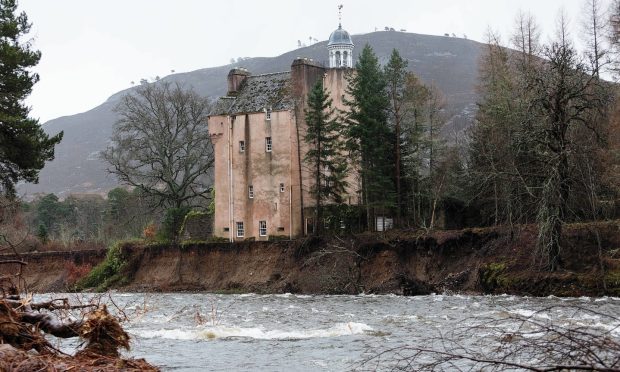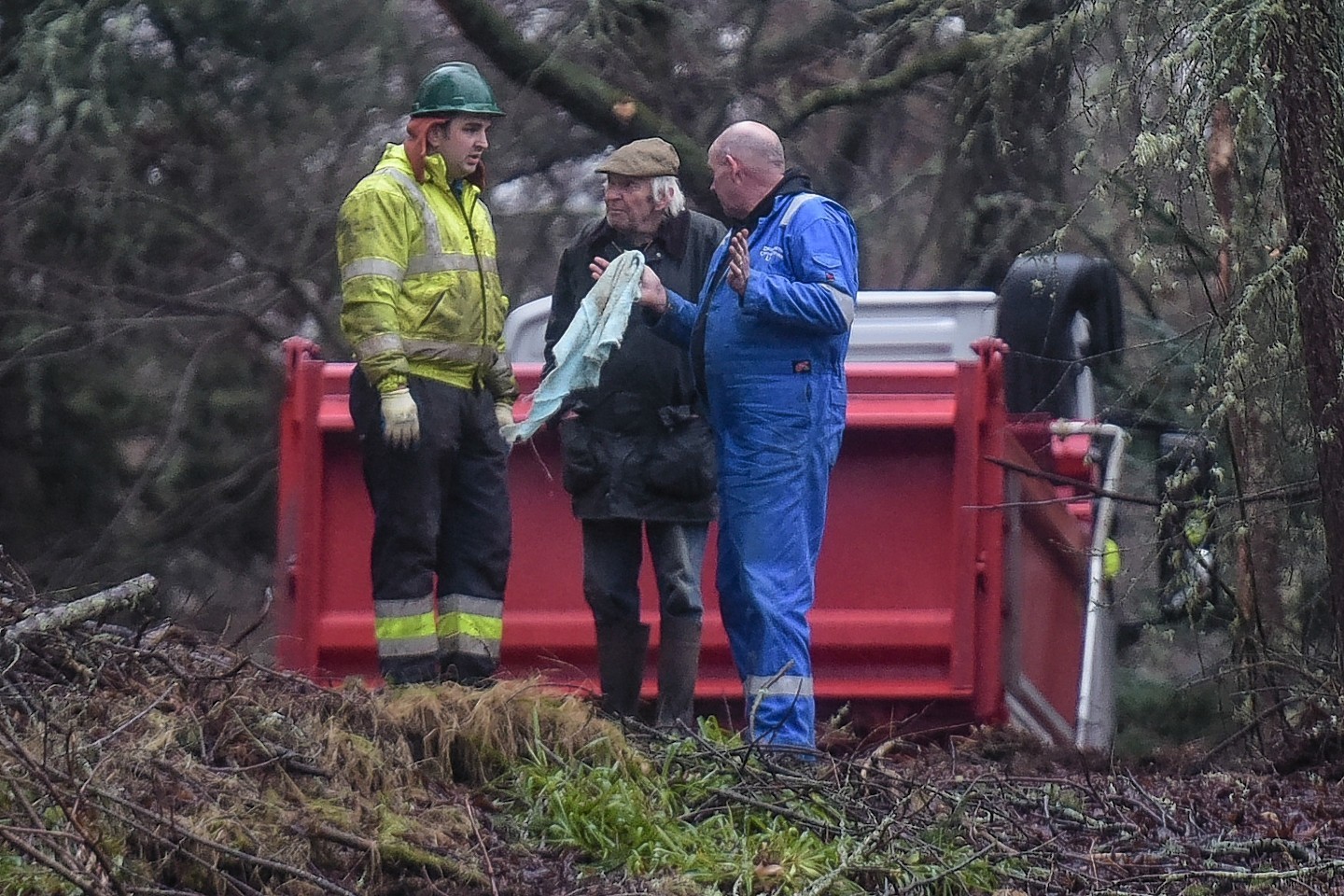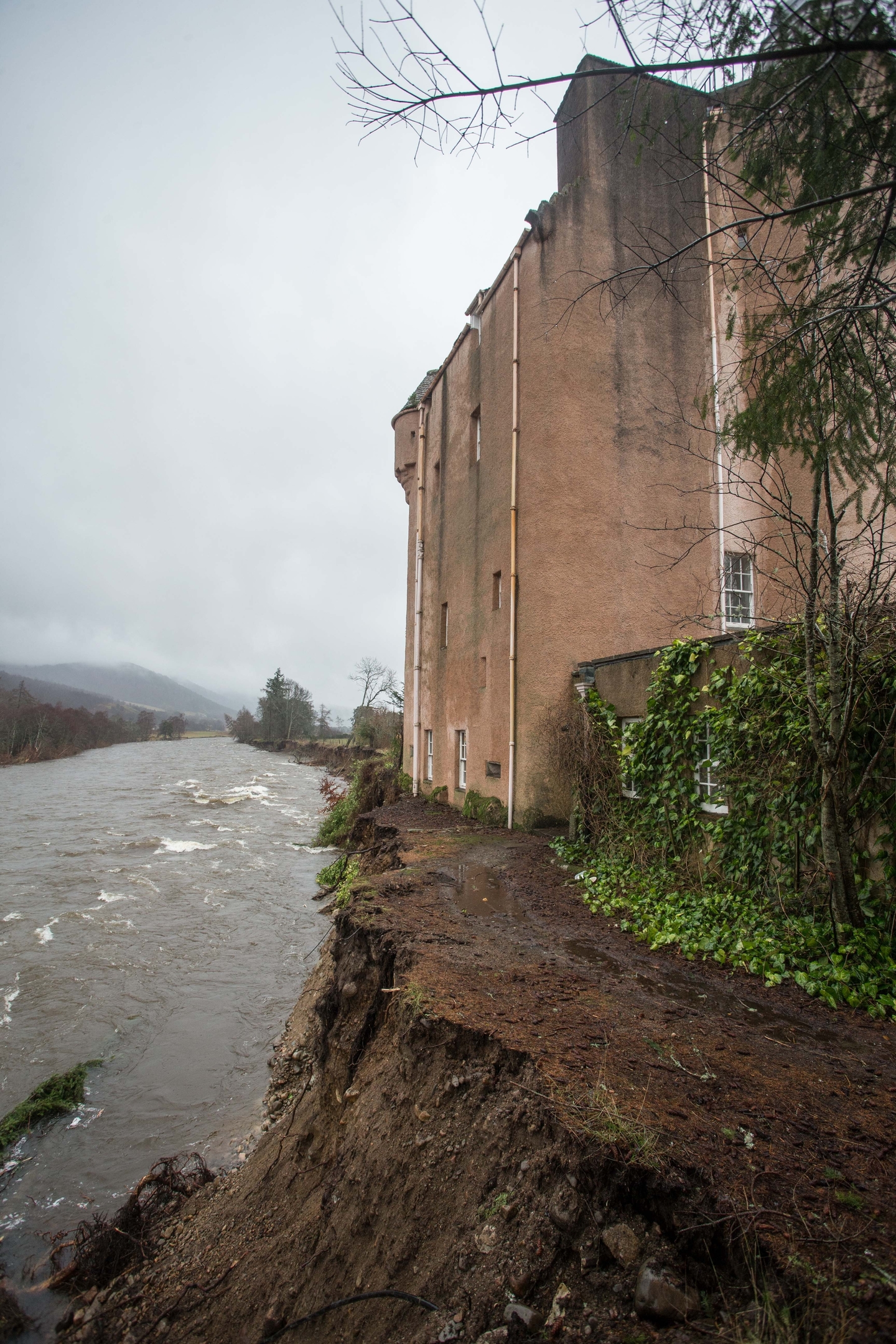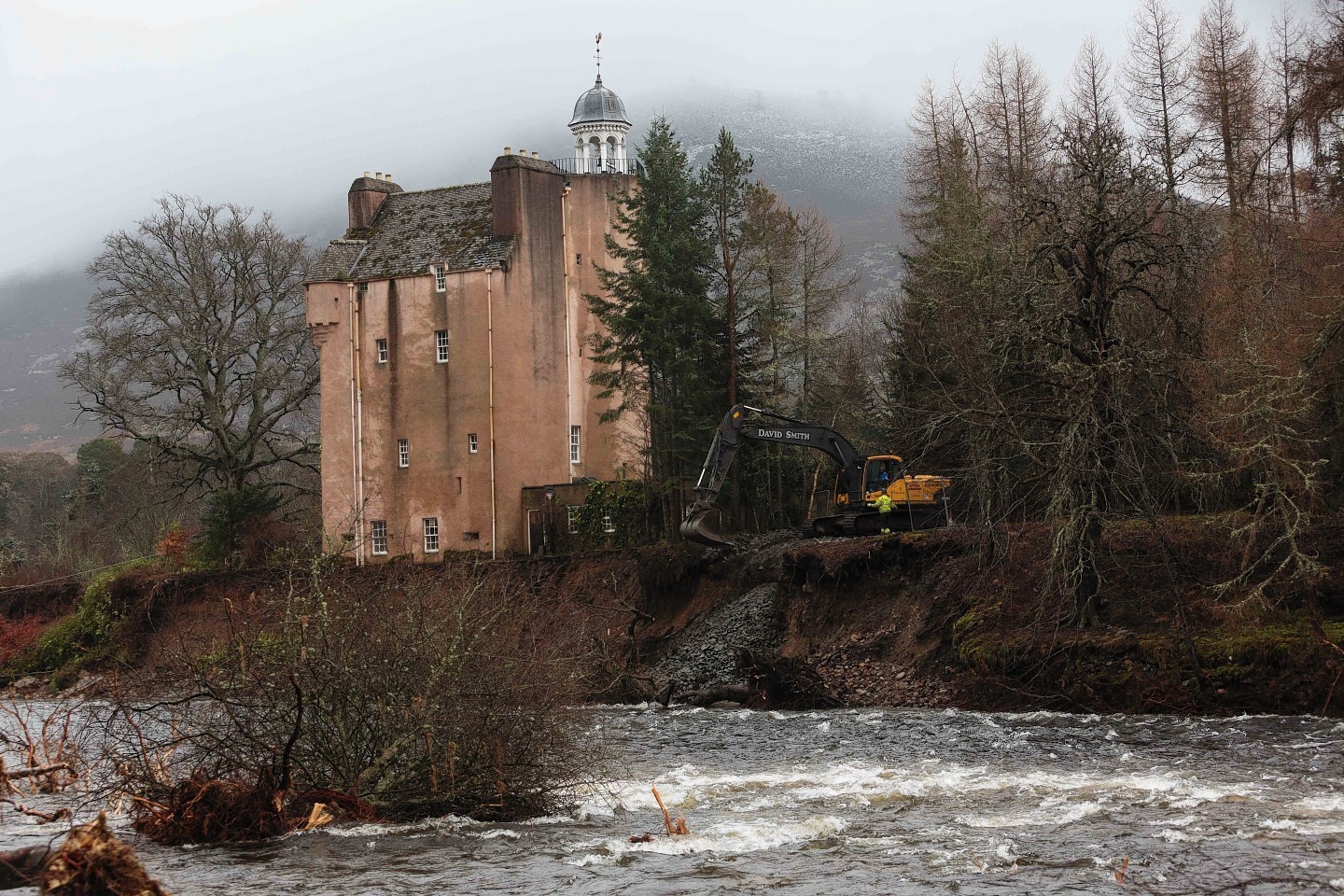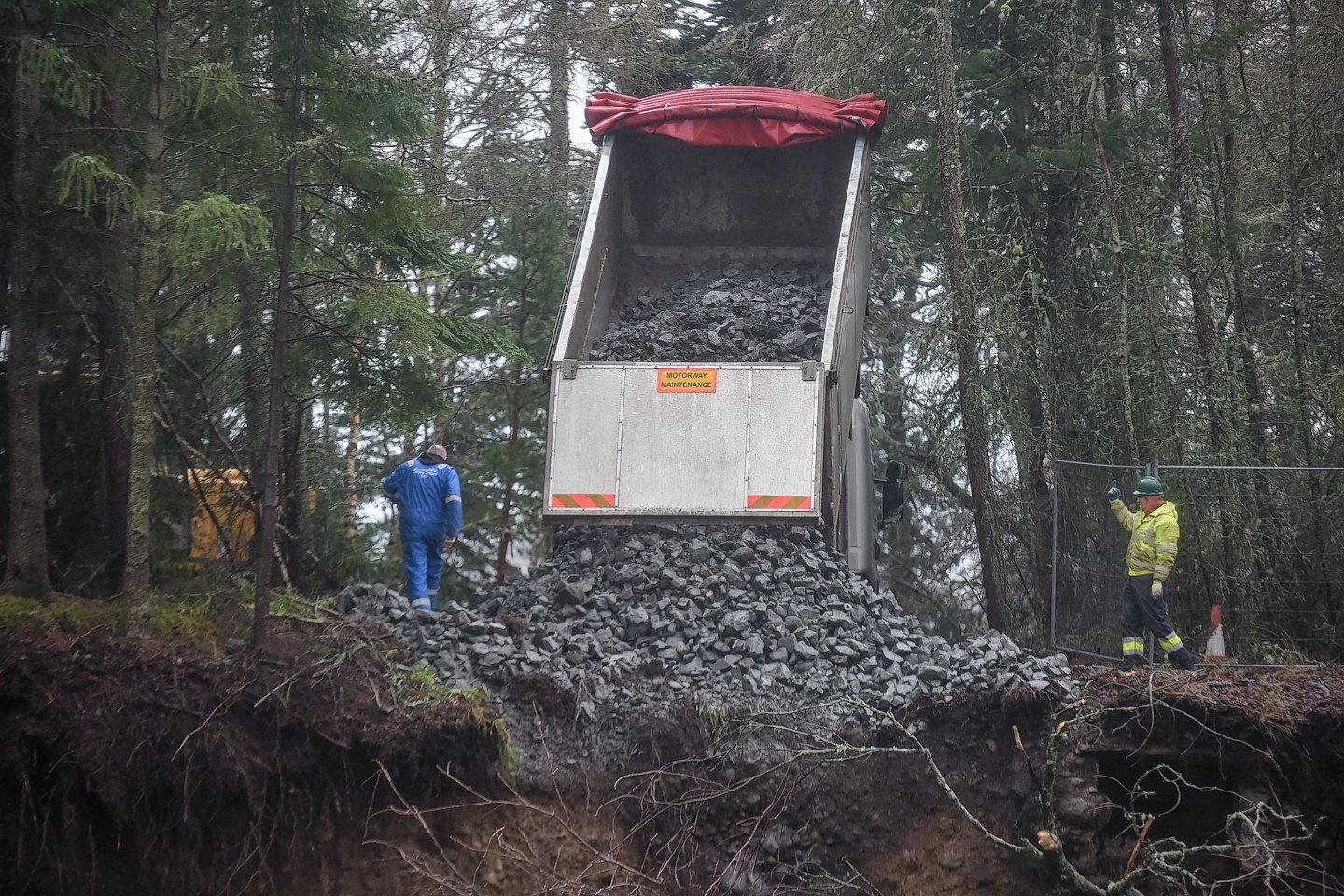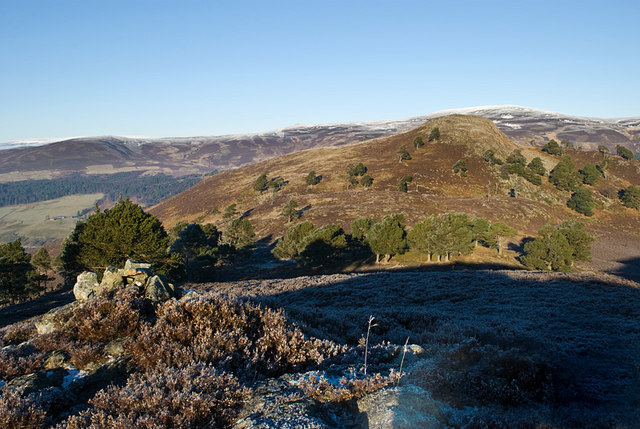A historic castle close to the Queen’s residence at Balmoral has been left on the brink of collapse into a swollen river after intense flooding.
The owner of Abergeldie Castle was forced to evacuate the 16th century A-listed tower house in Aberdeenshire on Sunday after the River Dee swept away about 60ft (18m) of land behind the property, leaving it only a few feet from the water.
It is understood that Baron Abergeldie, 76-year-old John Gordon, and his wife decided to leave their 450-year-old home when a wall in the garden was ripped away by the torrent.
They initially took refuge in a neighbour’s home before moving into another property on the estate. The laird is understood to be too upset to comment.
The Royal Family rented Abergeldie Castle, which is about two miles (3.2km) east of Balmoral, between 1848 and 1970 before Mr Gordon moved into his ancient family home in 1972.
Portions of the 11,700-acre sporting estate are regularly rented out to royalty for shooting and fishing.
The castle is an imposing building, its oldest part being a turreted square block-tower of the “tower house” style.
The walls are 4 feet thick, as was common for the unsettled nature of the times it was built.
It is thought that the castle was originally surrounded by a moat, but no trace of the watery deffence structure has ever been recorded.
In the 18th century a wing was added to the 16th century structu and by the 19th century an ogee-roofed belfry was built at the top of the stair tower, and a Venetian window inserted in the south façade.
W. D. Simpson, Scottish architecture and archaeology academic and writer, noted similarities between Abergeldie and the Castle of Balfluig at Alford, suggesting that they may have shared a designer.
The estate grounds extend 10 miles along Deeside, and consist of 11,700 acres planted with Scotch pine, larch, and birch, mixed in the private grounds with spruce, ash, plane, and sycamore.
The castle has one of the longest unbroken records of ownership, being in the hands of the Gordon family for 600 years.
It was most likely built around 1550 by Sir Alexander Gordon of Midmar, son of the first Earl of Huntly, on grounds acquired by the Gordon family in 1482.
The interior has been returned to its original state, restored by a descendant of the builder.
The castle was besieged by rebel forces during the first Jacobite rising in 1689-90, but was freed when General Hugh Mackay of Scourie marched with some cavalry and 1,400 Williamite Dutch infantry to lift the siege.
It figured again in the 1715 Jacobite Rising, being garrisoned by government troops (having then only recently been renovated by Rachel Gordon, 10th Heiress, and her husband, Captain Charles Gordon, who had also built nearby Birkhall, later sold to the current royal family) , and again in the short 1719 Rising, when it was briefly garrisoned by Spanish troops.
In 1848 Prince Albert, Victoria’s Consort, purchased the lease of the estate for 40 years, as Abergeldie was relatively close to the royal Scottish residence of Balmoral.
Birkhall, with an estate of 6,500 acres was bought from the Gordons by Albert the Queen’s Consort about the same time (though there has long been a local rumor that the Laird lost Birkhall in a card game).
Albert gave the property to his son Albert Edward (known by his family and intimates as “Bertie”), then the Prince of Wales (and future Edward VII). However, Queen Victoria claimed it back in 1885 (possibly because of Edward’s penchant for leading a dissolute life). After his marriage in 1863, he stayed every year at Abergeldy, indulging his twin passions of shooting by day and card-games by night.
The castle at present is occupied by the 21st Laird, John Seton Howard Gordon, Baron of Abergeldie, who has been living there since 1972 (the lands having been previously on lease to the royal family’s Balmoral estate, who had their lease on the game lands renewed in the year 2000).
The castle is said to be haunted by the spirit of a French serving woman named Catherine (or Kittie) Rankie (or Frankie), also known as French Kate.
She was accused of being a witch, and was imprisoned in the cellars before being burned at the stake on nearby Craig-na-Ban (Gaelic Creag-na-Ban – Rock of the Women), which overlooks the castle.
Since that time, Kate’s ghost has been said to have been seen in the cellars and in the clock tower.
It is thought Kitty found work in Abergeldie Castle and one day while the Laird was away overseas, the lady of the castle believed that Kitty had psychic powers.
“I have heard,” she said, “That you have the second sight, Kitty. Tell me news about my husband and what matters he is about.”
Kitty should have refused the request but she was pleased to have the good opinion of her lady. She took a basin, filled it with water and looked into the water.
Kitty saw the laird overseas, sporting with other women. She told her ladyship what she saw and her mistress professed herself not at all surprised to hear it, but even so, she was not at all pleased. In fact, she was very angry. She wanted Kitty to raise a storm at sea while her husband was aboard his ship, but that Kitty could not.
However, when the laird was at sea, a storm did arise by chance and it sank his ship and all aboard drowned.
When her ladyship heard she accused Kitty of witchcraft. She claimed that Kitty had raised the storm in order to kill the laird, her husband. Nothing Kitty said could convince the people otherwise. They took her to the top of Crag nam Ban and there they burned her to death.
Crag nam Ban isn’t a tall mountain, barely 500 metres, but the wind off the top is very rough and strong – and loud.
Locals have said that it isn’t the wind at all that they hear, that what they hear is the screaming of the ghost of Kitty Rankin.
